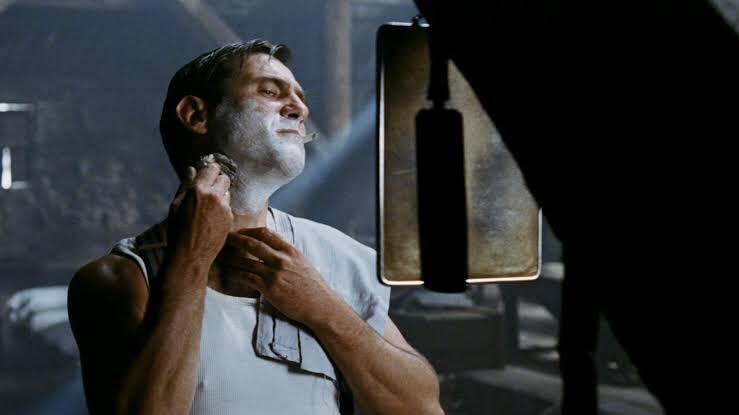We were tasked to analyse the key elements of film form of the “first shaving sequence” of Pan’s Labyrinth (00:24:36-00:26:13). This involved a detailed analysis of cinematography, sound, mise-en-scène, editing and performance during this sequence.
Cinematography
The scene opens on a closeup of the gramophone, silently informing us that music is about to start playing. The camera then fluidly tracks the movement of Vidal’s hand as he gingerly picks up his cutthroat blade. As the camera tilts upwards, our attention is pulled from the record player and is now focused on the captain’s face. As Vidal begins to walk towards the mirror, the camera transitions from a mid shot to a long shot, in order to display the surroundings. After a transition, the camera proceeds to arc around the captain and eventually pushes in on his face to present a mid-closeup of him meticulously applying shaving cream to his face. We then cut to an uncomfortable closeup of the captain shaving precisely with temporal focus. The final shot of the scene is a long shot, depicting the full scale of Vidal’s mechanically designed lair.

During the proceeding scene, the lighting becomes warmer which emphasises the fact that we are now in the presence of Mercedes. During the ensuing conversation between Vidal and Mercedes, the camera pedestals up to portray Vidal as having a more powerful position over her. As the captain reaches out to touch her shoulder, the two are framed claustrophobically which presents the captain as extremely threatening.
Sound
The first sound heard is the diegetic audio of the gramophone which is high in the mix. The chosen piece is “Soy un pobre presidiario” by Antonio Molina, a piece extremely evocative of the time period and one which oozes Spanish patriotism.
The song continues to play as Vidal applies shaving foam to his face, to which a diegetic brushstroke-like sound is layered in the mix. He then picks up the cutthroat razor, during which a universally recognisable “sharp metallic object” sound plays to emphasise to the viewer the precision with which the captain exerts during shaving. As the music ascends to fanfare-like crescendo, Vidal’s posture is reminiscent of a matador, further reinforcing his macho demeanour.
Mise-en-scène
At the beginning of the scene, we are greeted to a number of luxury items owned by Vidal. These include the gramophone, cigarettes and a deluxe cutthroat razor blade. These items reinforce the fact that the captain rules the hierarchy and therefore, the distribution of goods.
The razor blade itself is an accurate reflection of Vidal’s personality, requiring acute precision and diligence. The desk on which the shaving equipment lies is extremely cluttered, informing the viewer that this is the centre of Vidal’s command. The surroundings presented are reflective of Vidal’s mechanical disposition, the cog-like water wheels implying that he is a moving part of a bigger machine.
The surroundings presented are reflective of Vidal’s mechanical disposition, the cog-like water wheels implying that he is a moving part of a bigger machine. After we cut to a new scene, Vidal’s uniform is neatly presented and buttoned up as he addresses Mercedes. In addition to this, the interior is designed in a way which is extremely reminiscent of the “Pale Man room” which appears later in the film. This is one of many examples of subtle foreshadowing implemented by Guillermo del Toro throughout the film.

Editing
The scene opens on an initial long take as the captain picks up the cutthroat blade and walks towards the mirror. There is then an example of temporal editing, as the hidden cut signifies that an amount of time has passed between the transitions. After the transition, the camera is positioned in front of Vidal which is physically impossible if the camera kept moving in the same direction which it appears to be doing. As the captain dips his razor in the water, there is a glance object to focus our attention on the razor itself. The pacing throughout this sequence is relatively fast, matching the tempo of the music. As Vidal finishes shaving, there is an abrupt jump cut as the music comes to a final climax.
During the next scene, there is another glance object as Vidal looks at his boot while scrubbing it. During the conversation between Vidal and Mercedes, del Toro employs standard continuity editing techniques. These include shot/reverse shot sequences between the two characters as well as an eye line match. Additionally, the pace of the edit slows during their conversation in order to create a calmer atmosphere after the lively shaving sequence.
Performance
As the scene begins, Vidal’s movements are extremely precise and fluid as he glides his hand towards the razor. He moves meticulously to the carefully selected music and it becomes clear to the viewer that he treats the act of shaving as a divine ritual, emphasising his masculinity. It could also be noted that Vidal is shaving unnecessarily as he appears to be clean shaven. This potentially implies that Vidal views shaving as a form of detoxing to separate himself from his arduous pursuit of the rebels. It is also worth noting that a significant amount of time has passed during the process of shaving, due to the fact that his cigarette has become a stub by the time he has completed his shaving ritual.

During Vidal and Mercedes’ conversation, she appears to act as a mother figure towards Vidal, as she seems to be the only character to oppose him. In turn, this foreshadows her future defiance against Vidal later in the film. As Mercedes steps into the kitchen, each character seems to be more relaxed outside of the captain’s presence, which ultimately creates an untroubled atmosphere.